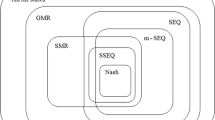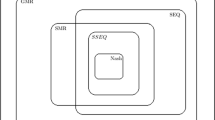Abstract
Stability definitions for describing human behavior under conflict when coalitions may form are generalized within the Graph Model for Conflict Resolution and algebraic formulations of these definitions are provided to allow computer implementation. The more general definitions of coalitional stabilities relax the assumption of transitive graphs capturing movements under the control of decision makers, either independently or cooperatively, and allow the convenient expansion to the case of coalitions of the four basic individual stabilities consisting of Nash stability, general metarationality, symmetric metarationality, and sequential stability. To permit the various coalitional stabilities to be efficiently calculated and conveniently encoded within a decision support system, algebraic expressions for the coalitional stabilities are provided in this research. Furthermore, a range of the theorems establish the mathematical credibility of employing the innovative algebraic approach to conflict resolution when coalitions are present. Finally, a conflict over the proposed exportation of bulk water from Lake Gisborne within the Canadian Province of Newfoundland and Labrador is modelled and analyzed to illustrate the practical application of the different coalitional stabilities and the strategic insights they provide.


Similar content being viewed by others
References
Abouelaoualim, A., Das, K. Ch., Faria, L., Manoussakis, Y., Martinhon, C., & Saad, R. (2008). Paths and trails in edge-colored graphs. Theoretical Computer Science, 409, 497–510.
Aumann, R. J., & Hart, S. (1994). Handbook of game theory with economic applications. Amsterdam: Elsevier.
Fang, L., Hipel, K. W., & Kilgour, D. M. (1993). Interactive decision making: The graph model for conflict resolution. New York: Wiley.
Fang, L., Hipel, K.W., & Wang, L. (2002). Gisborne water export conflict study. Proceedings of 3rd International Conference on Water Resources Environment Research 1 (pp. 432–436).
Fang, L., Hipel, K. W., Kilgour, D. M., & Peng, X. (2003). A decision support system for interactive decision making, Part 1: Model formulation. IEEE Transactions on Systems, Man and Cybernetics, Part C, 33(1), 42–55.
Fang, L., Hipel, K. W., Kilgour, D. M., & Peng, X. (2003). A decision support system for interactive decision making, Part 2: Analysis and output interpretation. IEEE Transactions on Systems, Man and Cybernetics, Part C, 33(1), 56–66.
Fraser, N. M., & Hipel, K. W. (1979). Solving complex conflicts. IEEE Transactions on Systems, Man, and Cybernetics, 9, 805–817.
Fraser, N. M., & Hipel, K. W. (1984). Conflict analysis: models and resolution. New York: Wiley.
Godsil, C., & Royle, G. (2001). Algebraic graph theory. New York: Springer.
Gondran, M., & Minoux, M. (1979). Graphs and algorithms. New York: Wiley.
Hipel, K. W., & Fraser, N. M. (1991). Co-operation in conflict analysis. Applied Mathematics and Computation, 43(181), 206.
Hoffman, A. J., & Schiebe, B. (2001). The edge versus path incidence matrix of series-parallel graphs and greedy packing. Discrete Applied Mathematics, 113, 275–284.
Howard, N. (1971). Paradoxes of rationality: Theory of metagames and political behavior. Cambridge, MA: MIT press.
Inohara, T., & Hipel, K. W. (2008a). Coalition analysis in the graph model for conflict resolution. Systems Engineering, 11, 343–359.
Inohara, T., & Hipel, K. W. (2008b). Interrelationships among noncooperative and coalition stability concepts. Journal of Systems Science and Systems Engineering, 17(1), 1–29.
Kilgour, D. M., Fang, L., & Hipel, K. W. (1990). A decision support system for the graph model of conflicts. Theory and Decision, 28(3), 289–311.
Kilgour, D. M., Hipel, K. W., & Fang, L. (1987). The graph model for conflicts. Automatica, 23(1), 41–55.
Kilgour, D. M., Hipel, K. W., & Fang, L. (2001). Coalition analysis in group decision support. Group Decision and Negotiation, 10, 159–175.
Li, K. W., Hipel, K. W., Kilgour, D. M., & Fang, L. (2004). Preference uncertainty in the graph model for conflict resolution. IEEE Transactions on Systems, Man, and Cybernetics Part A: Systems and Humans, 34(4), 507–520.
Nash, J. F. (1950). Equilibrium points in n-person games. Proceedings of the National Academy of Sciences, 36, 48C49.
Nash, J. F. (1951). Noncooperative games. Annals of Mathematics, 54(2), 286–295.
von Neumann, J., & Morgenstern, O. (1944). Theory of games and economic behavior. Princeton, NJ: Princeton University Press.
Shiny, A. K., & Pujari, A. K. (1998). Computation of prime implicants using matrix and paths. Journal of Logic and Computation, 8(2), 135–145.
van Deeman, M. A. (1997). Coalition formation and social choice. Dordrecht: Kluwer Academic.
Xu, H., Hipel, K. W., & Kilgour, D. M. (2009). Matrix representation of solution concepts in multiple decision maker graph models. IEEE Transactions on Systems, Man and Cybernetics, Part A: Systems and Humans, 39(1), 96–108.
Xu, H., Hipel, K. W., Kilgour, D. M., & Chen, Y. (2010). Combining strength and uncertainty for preferences in the graph model for conflict resolution with multiple decision makers. Theory and Decision, 69(4), 497–521.
Xu, H., Kilgour, D. M., & Hipel, K. W. (2010a). Matrix representation and extension of coalition analysis in group decision support. Computers and Mathematics with Applications, 60, 1164–1176.
Xu, H., Kilgour, D. M., & Hipel, K. W. (2010c). An integrated algebraic approach to conflict resolution with three-level preference. Applied Mathematics and Computation, 216, 693–707.
Xu, H., Kilgour, D. M., Hipel, K. W., & Kemkes, G. (2010b). Using matrices to link conflict evolution and resolution in a graph model. European Journal of Operational Research, 207, 318–329.
Xu, H., Kilgour, D. M., & Hipel, K. W. (2011). Matrix representation of conflict resolution in multiple-decision-maker graph models with preference uncertainty. Group Decision and Negotiation (GDN), 20(6), 755–779.
Xu, H., Kilgour, D. M., Hipel, K. W., & EdwardA, Mc Bean. (2013). Theory and application of conflict resolution with hybrid preference in colored graphs. Applied Mathematical Modelling, 37, 989–1003.
Zagare, F. C. (1984). Limited-move equilibria in \(2 \times 2\) games. Theory and Decision, 16, 1–19.
Acknowledgments
The author, Haiyan Xu, is thankful for the financial support from the National Natural Science Foundation of China (NSFC) (71071076) and National Social Science Foundation of China (12AZD102). The authors would also like to thank the National Science and Engineering Research Council (NSERC) of Canada for financial support.
Author information
Authors and Affiliations
Corresponding author
Rights and permissions
About this article
Cite this article
Xu, H., Kilgour, D.M., Hipel, K.W. et al. Theory and implementation of coalitional analysis in cooperative decision making. Theory Decis 76, 147–171 (2014). https://doi.org/10.1007/s11238-013-9363-6
Published:
Issue Date:
DOI: https://doi.org/10.1007/s11238-013-9363-6




